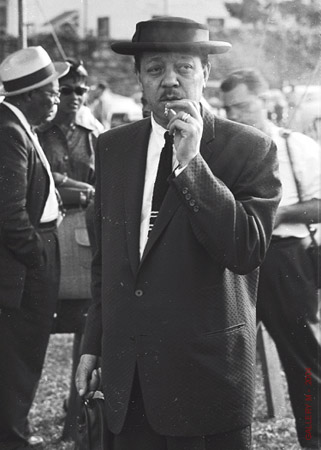Polka Dots and a Blindfold Test

Here’s some choice Lester Young material to complement the feature I’m presenting on him this week in Jazz à la Mode. My focus is Lester’s work as a leader in the forties and fifties after he’d come to prominence with Count Basie and begun making records under his own name. This period found the tenor saxophonist leading a succession of combos on a part-time basis. He’d begun touring with Jazz at the Philharmonic in 1946, which left fronting his own combo a secondary enterprise; as a result, changes in personnel were fairly routine. Consider the pianists Young played with between 1942 and ’55: Nat King Cole, Sam Price, Johnny Guarnieri, Kenny Kersey, Joe Albany, Hank Jones, Junior Mance, Kenny Drew, John Lewis, Oscar Peterson, Horace Silver, and Gildo Mahones. The only sideman to maintain a steady association with Lester was trumpeter Jesse Drakes who joined in 1948 and remained through the mid-fifties. Drakes was a Juilliard grad whose playing experience ranged from the Savoy Sultans to Harry Belafonte to Motown studio work; that he’s so little known outside of his recordings with Lester underscores how deep the ranks of trumpet greats were back in the day.

One of Lester’s favorite ballads was “Polka Dots and Moonbeams.” Composed by Jimmy Van Heusen and Johnny Burke in 1940 for Tommy Dorsey, it was Frank Sinatra’s first hit record. Sinatra, whom Lester admired as a vocalist, may have guided repertoire choices for Pres much like Ahmad Jamal did for Miles Davis. Lester first recorded it on his 1949 Mercury session with Hank Jones, Ray Brown, and Buddy Rich. His best known performance of “Polka Dots…” was made on a reunion with Count Basie at the Newport Jazz Festival in 1957.
The masterful performance, marred slightly by John Hammond’s intrusive introduction of Jo Jones over the opening phrase of Lester’s solo, is one of the highlights of Young’s late career. Coupled with his one-chorus solo on Billie Holiday’s “Fine and Mellow” on The Sound of Jazz television broadcast that same year, they serve as poetic and poignant capstones of Young’s highly personal art.
Here’s Lester playing “Polka Dots…” on an Art Ford Jazz Party television special. Ray Bryant is the pianist.
Two weeks ago, Loren Schoenberg of the Jazz Museum of Harlem posted on YouTube an excerpt of Leonard Feather’s interview of Young for a Blindfold Test that was published in Down Beat on November 2, 1951. It makes for fascinating listening as Lester talks about musicians and records, extols Bud Freeman as an original “stylist” and identifies his colleague Pee Wee Russell as part of the group playing “Dixielanderini.” (How I love Lester’s use of that suffix!) He also refers to a couple of the “bruising” experiences that had shaped his life, the “teardrops” shed over being harassed by Fletcher Henderson’s wife and sidemen for not conforming to the orthodox tenor style of Coleman Hawkins, and how something that went down with Basie “broke my heart.” Lester’s language is studded with the personal slang for which he was renowned; “nice eyes” is prominent in his expression of approval for some of the records played.